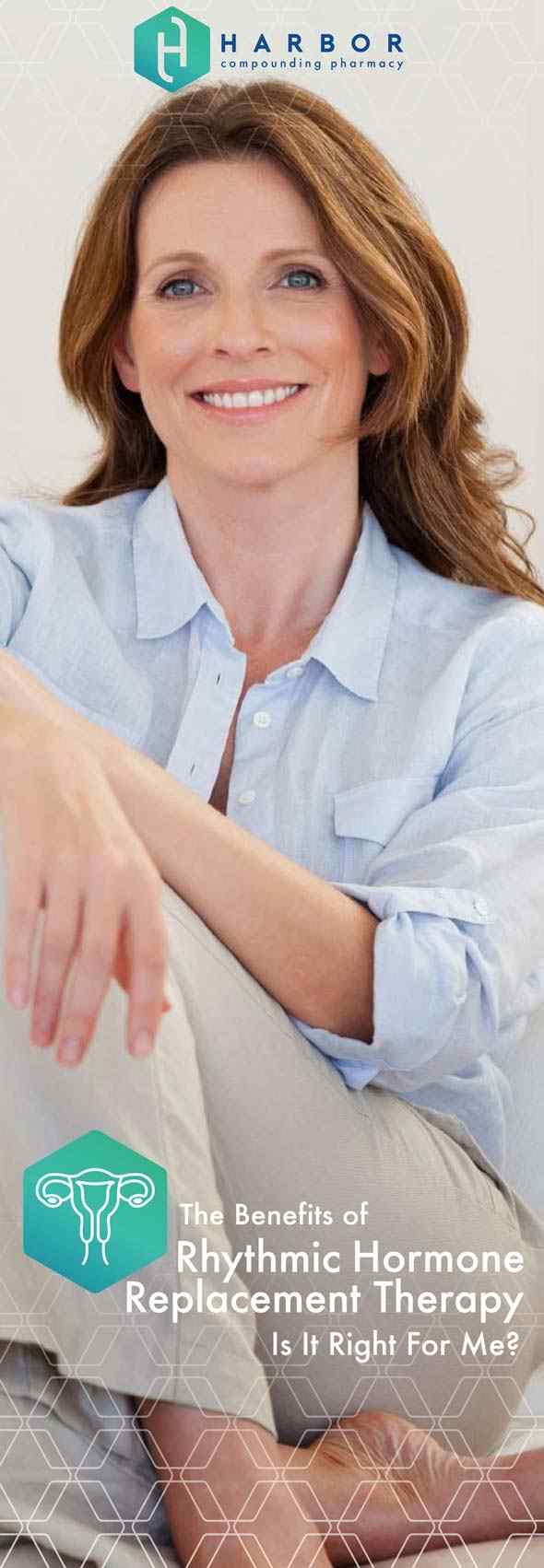


Most people women and men associate menopause with an end of the menstrual cycle: No more monthly periods. But that's just one of the significant biological changes that occurs and perhaps the most benign. The sharp decline in hormone production that occurs in menopause and the years leading up to it is also linked with increased risks for serious medical issues, including cardiovascular disease and unhealthy weight gain that can, in turn, increase the risks for other diseases. Hormone replacement therapy can help, but the most widely prescribed therapies use one-size-fits-all dosing strategies that present their own problems and risks. In recent years, rhythmic hormone replacement therapy has gained a lot of attention from the medical community and women are seeking a more natural, biologically-optimized approach aimed at reducing the bad effects of menopause and aging while helping avoid the risks associated with traditional hormone replacement treatments. If you're not familiar with rhythmic hormone replacement therapy, here's what you should know.
Hormones are chemicals produced by the body and used to regulate a host of functions, including metabolism, sleep cycles and sexual function. The two primary sex hormones in women include estrogen and progesterone. Although both estrogen and progesterone are most closely associated with sexual health and function, like other hormones, they can influence many other biological activities that have a bearing on overall health.
When women approach menopause, the production of these hormones drops precipitously, causing changes not just in sexual function and wellness, but in other functions as well. Women in perimenopause (or premenopause, the time prior to the cessation of periods) experience a broad array of symptoms like hot flashes, night sweats, weight gain, brain fog and mood changes that are associated with the decline in hormones. Once a woman enters menopause and menstruation completely stops, hormone-related changes continue, increasing a woman's chances of developing osteoporosis (brittle bones), some types of cancer and other serious medical issues that can take a significant toll on quality of life as well as contribute to mortality.
To counteract the decline in hormone production before and during menopause, scientists developed synthetic (lab-created) hormone replacements designed to supplement the body's own hormones to support normal, healthy function. In the past, hormone replacement therapy (or HRT) was the subject of controversy as early versions of synthetic hormones were found to be associated with an increased risk of several serious medical issues.
Many of these concerns arose because of subtle differences between the early lab-created hormones and the hormones naturally produced by the body; the lab-created hormones were similar, but not identical, to the natural hormones of the body. Normally, the body uses the hormones it needs and then eliminates the rest via natural processes and pathways. But the differences in the earlier versions of synthetic hormones inhibited the excretion and elimination processes, allowing excess hormones to build up, eventually creating dangerous levels of these potent chemicals.
Studies found taking these earlier versions of hormones could significantly increase a woman's chances of developing cancer in addition to causing other dangerous side effects. So scientists went back to the drawing board to develop synthetic hormones from natural plant sources that were chemically identical to the hormones produced by the body and bioidentical hormones were the result
Thanks to their identical chemical structures, bioidentical hormones are recognized as natural hormones by the body; the body cannot distinguish bioidentical hormones from naturally produced hormones. That means the body accesses these bioidentical hormones, processes them, uses them and eliminates the excess using the same mechanisms it uses to regulate hormones produced naturally. As a result, they're far less likely to cause unwanted side effects while also being more likely to promote normal, healthy, natural function.
But that's just one part of the story: During youth, hormone production occurs on a regular schedule, with peaks and troughs of estradiol and progesterone occurring throughout the 28-day menstrual cycle. In fact, it's these peaks and troughs of hormone blood levels that cause ovulation and menstruation, and they also play a role in a woman's overall health and wellness. Replacing hormones lost during menopause with a steady, daily dose only addresses half the problem replacing the lost hormones; it doesn't address the other half adjusting the dose daily to truly mimic the body's normal functioning. And that critical difference can have a major impact on the effectiveness of hormone replacement therapy.
Rhythmic hormone replacement therapy has gained considerable attention and popularity in the last decade as women and the scientific community have begun to recognize its potential benefits. In short, rhythmic hormone replacement therapy adjusts the dose of hormones on a regular, day-to-day basis, replicating a woman's natural hormonal cycle that becomes disrupted and ultimately abandoned during menopause. When a women is in her youth, her hormone production of estradiol and progesterone follows a predictable pattern, decreasing and increasing every day during each menstrual cycle. This natural rhythm plays a huge role in a woman's overall health it's the cycle her body was born to support.
Rhythmic hormone replacement therapy was developed to restore and support this natural cycle so the body can resume a more youthful biologic profile, naturally warding off many of the diseases and medical issues that arise when this cycle stops. Rhythmic HRT creates a more natural biologic environment and outcome compared to traditional HRT which uses a static, unchanging dose from one day to the next. In traditional HRT, any adjustments that are made to dosing occur much less frequently perhaps once or twice a year or less essentially creating an unnatural level of hormones that can contribute to an increased risk of disease instead of creating conditions that are natural, normal and supportive of women's health.
In fact, rhythmic hormone replacement therapy is so much like the body's natural hormone cycle, it can restart the menstrual cycle in some women, which means even a woman who has already entered menopause can see a return of her periods.
Of course, for many women, the cessation of her periods is viewed as the primary benefit of menopause no more cramping or monthly vaginal bleeding are considered one of the perks of getting older. But that's an optimistic and somewhat dangerous way of looking at those changes kind of like trying to see the glass as half full instead of half empty.
A woman's body is designed to undergo these monthly changes; generally speaking, the years during which a woman has her periods are also the years associated with the best health and wellness. Once hormone production declines and the natural cycle ends, the negative effects of aging can speed up dramatically. Restoring hormone production in a way that most closely mirrors the body's natural cycle means the body can return to the biologic profile designed to support optimal health with the aim of slowing the natural aging processes that contribute to disease and debility.
While natural hormone replacement therapy administered rhythmically is a relatively novel approach to menopause care, the theory behind it is well established within the medical community. In fact, birth control pills use a similar approach. These pills contain varying levels of hormones depending upon where a woman is in her cycle to control ovulation and prevent pregnancy. Rhythmic hormone replacement therapy is similar, but it uses different levels of hormones that vary more often during the month to specifically address menopause-related changes.
Changing doses frequently may seem like a lot of work, but most women find it's very easy to maintain a regular schedule that incorporates a range of doses throughout the month. Transdermal creams applied directly to the skin enable the hormones to be readily absorbed so they enter the bloodstream and go to work right away. Once therapy begins, many women report remarkable benefits soon afterward, enjoying more energy, better concentration and improvements in sexual desire and function, overall wellness, and quality of life.
Because it's a much more natural approach to restoring the body's healthy levels of hormones, rhythmic hormone replacement therapy can offer tremendous benefits to many women, but like any medical treatment, it may not be an ideal choice for everyone. Working closely with a medical professional skilled in rhythmic hormone replacement therapy is the best way to decide if the approach could be beneficial for an individual patient. To learn more about rhythmic natural hormone replacement therapy and how it can help women restore optimal health while avoiding the negative effects of aging, contact our compounding pharmacy today.



